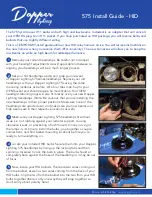
WWW.MANUALS.WS
WWW.MANUALS.WS
77
Your automatic transmission has a shift
lock system to minimize the possibility of
incorrect operation. This means you can
only shift out of “P” position when the
brake pedal is depressed (with the ignition
switch in “ON” position and the lock re-
lease button depressed).
(a) Normal Driving
1. Start the engine as instructed in “How
to start the engine” in Part 3. The trans-
mission must be in “P” or “N”.
2. With your foot holding down the brake
pedal, shift the selector lever to “D”.
In “D” position, the automatic transmis-
sion system will select the most suitable
gear for running conditions such as nor-
mal cruising, hill climbing, hard towing,
etc.
Always turn the overdrive switch on for
better fuel economy and quieter driving. If
the engine coolant temperature is low, the
transmission will not shift into the over-
drive gear even with the overdrive switch
on.
Never put your foot in the accelera-
tor pedal while shifting.
CAUTION
!
3. Release the parking brake and brake
pedal. Depress the accelerator pedal
slowly for smooth starting.
(b) Using engine braking
To use engine braking, you can downshift
the transmission as follows:
Turn off the overdrive switch. The “O/D
OFF” indicator light will come on and
the transmission will downshift to the
third gear.
Shift into the “2” position. The trans-
mission will downshift to the second
gear when the vehicle speed drops
down to or lower than the following
speed, and more powerful engine
braking will be obtained.
Two-wheel drive models
108 km/h (67 mph)
Four-wheel drive models
215/70R16 tires
96km/h (60 mph)
235/60R16 tires
93 km/h (58 mph)
Shift into the “L” position. The trans-
mission will downshift to the first gear
when the vehicle speed drops down to
or lower than the following speed, and
maximum engine braking will be ap-
plied.
Two-wheel drive models
55 km/h (34 mph)
Four-wheel drive models
215/70R16 tires
44 km/h (27 mph)
235/60R16 tires
43 km/h (27 mph)
Be careful when downshifting on a
slippery surface. Abrupt shifting
could cause the vehicle to spin or
skid.
CAUTION
!
(c) Using the “2” and “L” positions
The “2” and “L” positions are used for
strong engine braking as described pre-
viously.
With the selector lever in “2” or “L”, you
can start the vehicle in motion as with the
lever in “D”.
















































